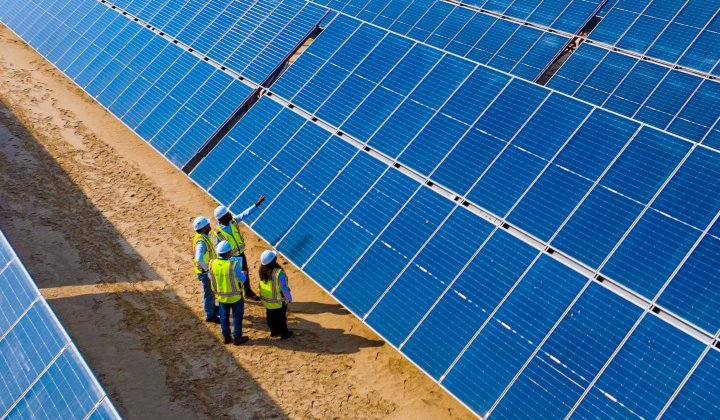Nature’s gifts of the sun, sea, and wind have long made South Africa a popular inbound destination. The country, however, has the potential also to become a popular outbound supplier of the fruits of its environmental bounty. As climate consciousness and troubling weather events make current practices untenable, new solutions are being sought for how modern society can continue to function in more sustainable ways. Green hydrogen is a solution increasingly being highlighted because it is produced by renewable materials.
When water, solar, or wind power are used to split water into its constituent elements of hydrogen and oxygen, the hydrogen is referred to as "green" because the process of producing it has been mostly carbon-free. Green hydrogen is likely to become a preferred commodity in years to come, and South Africa is well positioned to deliver to countries that aren’t able to produce it in the required amounts and timeframes.
In 2021, the global green hydrogen market was valued at $3.2 billion, and predictions are that it is set to expand by almost 40% by 2030. Becoming a major exporter of green hydrogen could not only cut South Africa’s own greenhouse gas emissions by 70%, but could also create jobs and boost the country’s long-term energy security.
Speaking at the inaugural Green Hydrogen Summit in November 2022, President Cyril Ramaphosa shared that South Africa “has the potential to produce six to 13 million tonnes of green hydrogen and derivatives a year by 2050”. Though the summit was a new initiative, Ramaphosa revealed that the Department of Science and Innovation has been leading research into green hydrogen since 2007.
Over the past few years, more attention and resources have been allocated to this nascent industry. The 2021 Sustainable Infrastructure Development Symposium highlighted South Africa’s potential as a global exporter of green energy, while the 2022 UN Climate Change Conference (COP 27) at Sharm el-Sheikh in Egypt was leveraged to elaborate on the country's green transition.
Speaking at the second Green Hydrogen gathering in Cape Town in October 2023, Ramaphosa highlighted the potential benefits of the alternative energy source. “It has been estimated that the hydrogen economy has the potential to add 3.6% to our GDP by 2050, and approximately 370 000 jobs.”
Aiming high
South Africa has the natural resources to become a large-scale, low-cost, world-class hydrogen producer and exporter. It can become a total value chain investment destination. There’s also massive potential to partner with other countries as is being done through the Africa Green Hydrogen Alliance, which includes Egypt, Kenya, Mauritania, Morocco, Namibia, Ethiopia, and Angola.
This alliance aims to harness Africa’s potential in developing green hydrogen industries, and to make joint calls for technical support, funding and market access to international public and private sector partners.
Alongside these intra-continental deals, South Africa is also building its own relationships with potential partners. The country has a Joint Declaration of Intent with the German government focusing on market access, off-take opportunities, and value-additive benefits in the production of green steel and green fertiliser. The country has also signed a Memorandum of Understanding with the Netherlands as an off-taker for green hydrogen derivative products. Additionally numerous deals and collaborations are in effect such as the Memorandum of Cooperation between Sasol, Anglo American and BMW, who are three of the biggest multinationals in the green hydrogen mobility space.
During a webinar on renewable hydrogen and green powerfuel opportunities for South Africa, Fleetwood Grobler, CEO of Sasol, and Andrew Kirby, CEO of Toyota South Africa, revealed plans of a long-term joint venture between the two companies.
Using one of South Africa’s main freight corridors, the N3 route between Durban and Johannesburg, the organisations aim to work together to develop a green hydrogen mobility corridor for hydrogen-powered heavy-duty long-haul trucks.
Kirby explained that hydrogen-fuelled vehicles can revolutionise the long-distance and heavy-duty transport required by sectors such as mining and logistics. “Hydrogen is as safe as petrol and diesel, and it's extremely reliable – there are fewer moving parts than internal combustion engines. Hydrogen is denser than, for example, lithium batteries or liquid natural gas, there are significant range advantages, and refuelling time is quick. Hydrogen is obviously also significantly lighter than other fuels.”
Additionally, South Africa has announced the Just Energy Transition Investment Plan. Spanning a five-year period from 2023 to 2027, the initiative sets out the expenditure strategy for a financial package of $8.5 billion, which has been pledged by the European Union, the United Kingdom, and the United States as part of the Just Energy Transition Partnership between the countries.
While the plan supports South Africa’s goal of achieving a low-carbon economy and a climate-resilient society, the country's current electricity crisis could not be ignored. Interventions that have been prioritised, according to the plan, include “increasing our energy security and ending load-shedding through a massive rollout of new, sustainable energy sources”, while also looking ahead to “creating quality jobs in new sectors like electric vehicles, green hydrogen, renewable energy, and manufacturing”.
A portion of the investment funds are set to go towards the development of a so-called "hydrogen valley". This is a planned integrated hydrogen ecosystem stretching from Mokopane – where platinum group metals are mined – trailing through Johannesburg, and then ending in Durban. Over a stretch of approximately 835 kilometres, the valley will present employment and investment opportunities, while also contributing towards the related strategy of moving the country away from dependence on coal. A feasibility study conducted independently showed that the project could add anywhere between $4 billion to $9 billion to South Africa’s GDP.
Practical realities
Natural elements have made their contribution but there’s still much more required to realise a green hydrogen economy in South Africa. Many sectors such as shipping, power generation, construction, and aviation will be transformed by green hydrogen. But the industry itself is still in its infancy. In a fledgling sector such as this, passion and purpose are as important as the practicalities.
For the local market to fulfil what will become ever-increasing demand from countries in harsher climates, South Africa needs to train and develop a green hydrogen workforce that will be able to fulfil the country's goals.
Linked to this new infrastructure development, South Africa will also need to resolve the existing acute water shortages experienced in the past few years. This needs to be done expediently so that water required for the production of green hydrogen is not redirected or withheld from communities needing water for everyday life. Acknowledging the complexity of the situation, a Council for Scientific and Industrial Research (CSIR) report suggests different approaches. It recommends that feedwater for hydrogen for export and coastal use ought to be desalinated seawater so that the hydrogen can be produced and dispatched near the port of shipment. For inland domestic use, feedwater should be derived from desalinated or treated water from sources that are heavily contaminated and are otherwise not treatable by municipal wastewater treatment plants. Alternatives to tap water include mine water, acid mine drainage and industrial wastewater.
Another concern is that the swathes of land required for hydrogen plants and factories could displace indigenous people, violate cultural and ancestral landmarks and endanger the very natural environment being leveraged for its resources. Hydrogen gas is also highly volatile if not handled properly. When it is alight, flames are invisible to the naked eye, making it difficult to contain fires and prevent explosions. This could be highly dangerous for workers at a hydrogen plant and for nearby communities. Additionally, the financial burdens on both citizens and the state will only increase if capital is redirected to hydrogen projects instead of the existing problems across healthcare, roads, and safety.
The hydrogen economy journey
Some of the significant events and launches that signify South Africa’s moves towards better a energy source
- 2007: Cabinet approved the National Hydrogen South Africa (HySA) RDI Strategy.
- 2010: SA’s first hydrogen bike, the A Hi Fambeni, was rolled out. It was developed by students of the Tshwane University of Technology in partnership with the Department of Science and Technology and Hydrogen SA.
- 2012: Cape Town hosted the 17th International Partnership for Hydrogen and Fuel Cells in the Economy (IPHE).
- 2014: Dr. Phil Mjwara launched a fuel cell unit at the University of the Western Cape Nature Reserve, and there was also the launch of fuel cells for off-grid rural electrification in Naledi Trust Village in the Free State
- 2017: The HySA Competitive Fund was introduced to facilitate collaboration with industry.
- 2018: South Africa hosted the 30th IPHE meeting, and shared updates on encouraging developments from the previous few years such as the fuel cell units launched at Windsor East Clinic in Randburg, Johannesburg, at Poelano Secondary School in North West, and the fuel cell forklift and refuelling station at Impala Platinum Refineries.
- 2020: The triple helix partnership facilitated government's rapid response to Covid-19. Fuel cells were deployed to power the Covid-19 field hospital at 1 Military Hospital in Pretoria.
- 2021: The Industrial Development Corporation (IDC) was mandated to develop the Green Hydrogen Commercialisation Strategy, and the establishment of the Platinum Valley (SA's Hydrogen Valley) was announced during the debate following the president's State of the Nation address (Sona).
- 2022: The inaugural South Africa Green Hydrogen Summit was held. It aimed to showcase the country’s offering as a world class green hydrogen production hub and investment destination.
Opportunities for discovery and innovation
A report by the International Energy Agency reveals that hydrogen patents have been on a remarkable rise between 2011 and 2020. These are the three main areas in which companies are applying.
Hydrogen production: Electrolysis technologies have been the key driver of innovation in hydrogen production over the past two decades. They are currently the most promising method of hydrogen production from water, with higher efficiency than other methods. Patenting trends in hydrogen production technologies over the past twenty years show a necessary shift from traditional, carbon-intensive methods to new technologies with the potential to decarbonise hydrogen production.
Storage, distribution and transformation: Hydrogen is the lightest and smallest element, and is also highly flammable. Innovation needs to help tackle the challenges of storing, moving, and delivering the energy in hydrogen. Without effective and cost-efficient systems for storing and transporting hydrogen between where it is produced and where it is consumed, large-scale hydrogen deployment will not be possible. Specialist equipment to contain it and move it around are potential areas for investment and development.
End-use applications: These are technologies that seek to make it more attractive or cheaper to use hydrogen to make products or supply energy services, including transportation, heat, and power. Road transport, particularly passenger cars, has been the main focus for hydrogen innovation. Patenting in this area has grown at an average annual rate of 7% over the past decade. In aviation, applications are dominated by innovation for unmanned aircraft or drones, while for passenger and cargo aircraft, there is an expectation that hydrogen and fuel cells could be the most competitive options for medium-haul flights. Other sectors with high patent activity include iron & steel production, electricity generation, buildings and upgrading of biofuels.
Five actions to grow the green hydrogen economy
Yershen Pillay, CEO of the Chemical Industries Education and Training Authority (CHIETA), and GIBS MBA class of 2020 alum, highlights how South Africa can become a global leader in green hydrogen production.
- South Africa needs to train and develop a green hydrogen workforce that will be able to fulfil the country's goals. To ensure that critical skills are sourced locally as much as possible, the Chemical Industries Education and Training Authority has identified 17 future skills for success in the hydrogen economy. These include hydrogen fuel technicians, systems engineers, power system electricians, storage specialists, electrolysis engineers, and safety specialists.
- Hydrogen infrastructures must be developed. This entails shifting the current state of hydrogen projects from pre-feasibility and feasibility to actual investment. Hydrogen initiatives in South Africa also need swift execution. The slow pace of execution of hydrogen infrastructure projects could significantly stifle the growth of our hydrogen economy.
- Legislation, policy, and regulations must be introduced to facilitate a more enabling environment. What we need is not debilitating regulations, but transformative regulations that mitigate the risks associated with all aspects of the hydrogen economy. South Africa needs a coherent national hydrogen policy and a standardised hydrogen certifications framework. The development of enabling legislation, policies, and regulations for effective risk mitigation is a key driver of growth.
- Government support schemes need to be established. Deliberate and intentional government support would ensure the localisation of hydrogen opportunities. Some ways to achieve this could be a Hydrogen Innovation Fund and Hydrogen Bank, with a dedicated support fund for hydrogen-related SMMEs. Government support schemes for hydrogen are not new and examples can be found in other parts of the world. Countries such as Morocco have witnessed an almost 30% share of hydrogen production being attributed to local SMMEs.
- There must be better coordination and more cross-sector collaboration. However, the role of coordinating all stakeholders in the hydrogen economy should be left to government. The private sector cannot play the role of coordination as its primary focus would be profit maximisation. But, as an enabler of growth and development, government could facilitate structured collaborative agreements between the energy, chemicals, transport, agriculture, and mining sectors, which are the leading industries in the hydrogen value chain.






